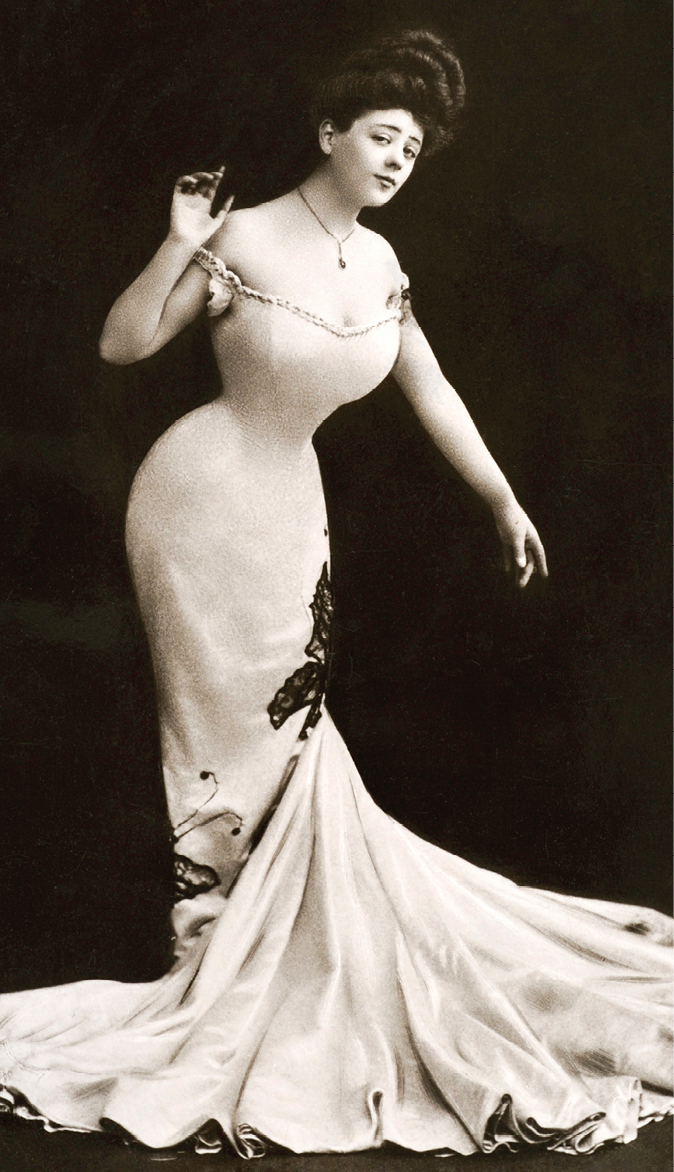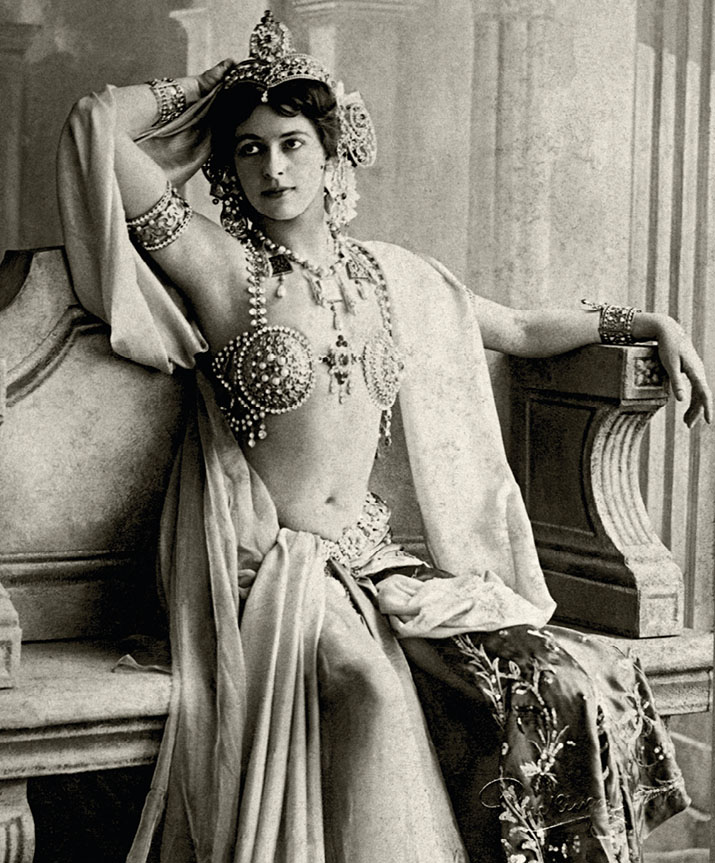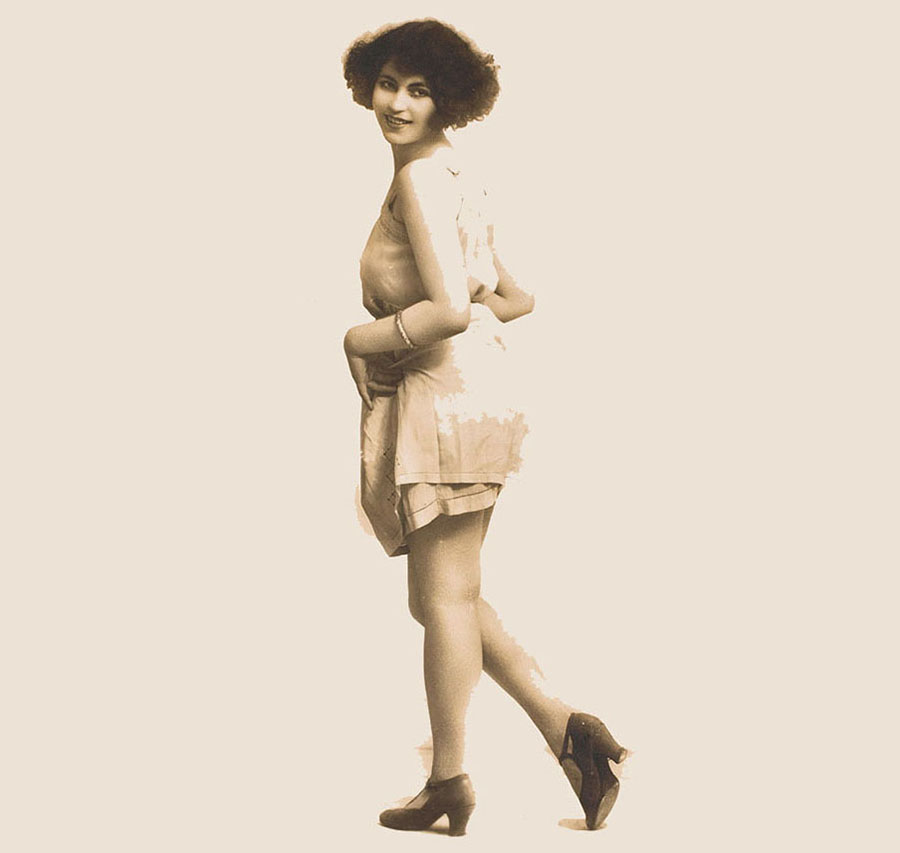Chapter Four
Innovation and Invention
After the Victorian era, King Edward VII became Britain’s reigning monarch, and the years of his rule (1901–1910) are known as the Edwardian era. It was characterized by massive social, technological, and economic upheaval in American and European society. As cities grew larger and citizens intermingled, class distinctions began to crumble. Social mores changed. Some women continued to demand equal rights. Others were clinging to rigid, traditional values of earlier times. This clash of new and old, combined with technological and manufacturing advances, created an explosion of change in women’s undergarments. Innovation and invention were the sign of the times.
A Passion for Peddling
One of the most liberating inventions for women was the bicycle. The cycling craze really got cranking in the 1890s and continued into the twentieth century. Suddenly European and American women could go where they wanted—without a male chaperone. As long as they had something to wear that was comfortable, they could move about unconstrained. These athletically minded young women wore a shorter and looser corset, sometimes called a waist, in which it was much easier to peddle and to breathe. They asked their tailors to add pockets to their cycling costumes so they could carry personal belongings easily. And since these cyclists were often alone, they also had tailors add leather-lined pockets designed to discreetly carry pistols for protection.
Ice-skating, gymnastics, tennis, skiing, and horseback riding became popular among women, and they needed comfortable clothes to participate. Suddenly divided skirts called culottes and knickerbockers (baggy trousers) were popular, even if rejected by high fashion. Women who liked to swim didn’t want to struggle in the water weighted down by yards of fabric skirts. In 1907 Australian swimmer Annette Kellerman (1887–1975) was arrested in Boston, Massachusetts, for wearing a boy’s bathing suit over tights. Her body was covered but not concealed. Apparently that was too much for citizens to handle! Kellerman, however, was unfazed. She went on to tour in mermaid stage shows, pioneered what is called synchronized swimming, and was the first woman to appear fully nude in a movie, A Daughter of the Gods, in 1916. Other female swimmers followed her lead. Soon many women were wearing bathing suits that clung to the body and looked something like a tank top sewn to a pair of knee-length shorts.

Annette Kellerman in her famous one-piece swimsuit. Her choice was viewed as scandalous because it revealed the true shape of her body.
The Gibson Girl

Charles Gibson drew his illustrations from real-life models, including Camille Clifford (above), a Danish-born actress. The Gibson Girl represented the era’s female ideal: a more athletic and self-possessed woman. However, the tight corset and exposed bust did not actually encourage strenuous sporting activity.
In spite of the successes of the rational dress movement in liberating women from restrictive corsets during sports, mainstream style was as constrictive and uncomfortable as ever. In the Edwardian era, the ideal woman was the Gibson Girl, portrayed in pen-and-ink drawings by American artist Charles Gibson. She was a blend of all that high society considered beautiful at the time: pale white skin, delicate features, a rosebud mouth, hair loosely piled upon her head, and the distinctive hourglass figure created by a specialized corset.
The Gibson Girl corset had an extra-long central busk that went from the pubic bone to just under the breasts. When tightly cinched, it pushed the chest forward and the rear backward. From the side, the woman had a distinct S-shaped form. The breasts themselves were unsupported, and women used various pads and shapers called corset covers, which were made of stays and fabric, to give the bosom a smooth, forward-jutting silhouette known as the monobosom.
The Gibson Girl was often depicted in art and advertisements cycling, golfing, or participating in other athletic events. She was supposed to represent a healthy yet modest woman, who showed no sign of exertion, never perspiring and with never more than a wisp of hair out of place. Yet it’s doubtful a real Gibson Girl could actually have done any of those activities wearing the type of corset that was worn then.
For a brief period around 1910, the corset metamorphosed one more time. The dramatic S-shape vanished. The latest dress styles were long and slim. Corsets lengthened to accommodate the fashion, and the Gibson Girl was gone.
Birth of the Bra
The corset too, as an everyday piece of apparel, was on its way out. Back in 1889 at the Grand Exhibition in Paris, French lingerie designer Herminie Cadolle had displayed a patented garment she called the corselet-gorge. Basically, this was a corset cut in half to form a top piece with shoulder straps to support the breasts and a bottom piece to shape the waist. Later, she sold the top half by itself at her lingerie shop in Paris, calling this early bra le bien-être, or the “well-being.” By 1905 the shop was selling it as the soutien-gorge, which translates as “breast supporter.” In 1905 Cadolle made a spectacular metal bra for Mata Hari (1876–1917), a Dutch exotic dancer and courtesan who was also a spy for the French government. Herminie Cadolle’s high-end lingerie company, called Cadolle, still exists and is run by Poupie Cadolle, the great-granddaughter of Herminie Cadolle. Each piece of lingerie is custom-made and finished by hand, which takes up to thirty hours. Cadolle even made the sexy black corset that Monica Bellucci wore in the 2015 James Bond movie Spectre.

Dutch exotic dancer and courtesan Mata Hari (above) wears a metal bra designed by Herminie Cadolle. Cadolle began calling her bras soutiens-gorge, which is the word still used for “bra” in the French language.
Another woman who claimed to be the inventor of the bra was American socialite Mary Phelps Jacob (who later changed her name to Caresse Crosby). In 1913, when she was twenty-two years old, she was getting ready for a high-society party. As was the style, she laced into her corset, which ended under the breasts, and put on a stiff, laced upper garment called a corset cover. She recalled that it was “a box-like armour of whalebone and pink cordage,” and it showed through the sheer fabric of her evening gown. Struck by inspiration, she and her maid quickly sewed together two lightweight silk pocket handkerchiefs and some pink ribbon to form a delicate backless undergarment that covered and contained Crosby’s breasts. She said that it was “delicious” to wear. Crosby could dance with abandon. At the party, other young women commented on how smoothly her gown fitted. Crosby showed them her invention, and all of her friends wanted one. So Crosby started sewing. Eventually total strangers were offering to buy Crosby’s bras for one dollar apiece. Crosby patented her “backless brassiere” in 1914—the first bra patent in the United States—and eventually sold the design to Warner Brothers Corset Company for $1,500. In her 1953 autobiography, The Passionate Years, Crosby wrote, “I can’t say the brassiere will ever take as great a place in history as the steamboat, but I did invent it.”
The Fashions of War
Everything changed with the eruption of World War I (1914–1918) in Europe. American and European women took jobs in munitions (weapons) factories and served as railway guards, firefighters, bus and train conductors, police officers, and military nurses. Many of these jobs could not be done well or easily in dresses, so women began to wear trousers regularly for the first time. The calf- or knee-length, open-crotch drawers that women had been wearing didn’t work well under pants. So women began to wear shorter, closed-crotched drawers—known as knickers, or step-ins. These were the precursors of modern underwear.
In 1917, after the United States joined the war, American financier Bernard Baruch became the chairman of the War Industries Board and oversaw the purchase of war supplies. To make battleships and other equipment, US manufacturers needed as much steel as possible. Baruch knew that corset stays were made from steel, so he made a desperate plea to American women: stop wearing corsets! Thanks to the women who unlaced for the cause, the military was able to collect enough steel to build an entire battleship—28,000 tons (25,401 t)!
But women were not accustomed or inclined to go completely without supportive undergarments. They began wearing the newfangled bras. To contain and flatten their stomachs, thighs, and bottoms, women turned to a brand-new garment. The girdle was a one-piece, tube-shaped undergarment that sheathed a woman’s body from under the breasts to mid-thigh. The girdle was made possible by the invention of elastic fabrics. A new manufacturing technique turned latex sap from trees into stretchy rubber. Rubber could be made into a wide range of products from tires for cars to sneaker soles to elastic for clothing. Elastic materials were relatively inexpensive, and they eliminated the need for laces in lingerie. A woman could slip on her girdle and have flexibility and ease of motion.
After the invention of the girdle, another brand-new kind of lingerie called camiknickers came on the scene. This was a one-piece combination of a bra-like top called a camisole and the new, short knickers women had been wearing. Camiknickers were perfect under the new girdles because they eliminated the gap between bra and underwear. The combination of girdle and camiknickers was also perfectly suited to the new fashions of the 1920s.

One-piece camiknickers were popular during the Jazz Age. They created a smooth silhouette under the lighter, looser-fitting dresses of the era.
The Jazz Age
The ideal woman of the 1920s was slim and small-breasted, almost boyish in her appearance. The so-called It Girl of the 1920s was movie star Clara Bow. She was tiny, perfect for the sleek styles of the day. Women wore barely there sheath dresses of delicate materials. The new elastic girdles, also known as belts, created a smooth silhouette under the fashionable dresses of the time.
And could you dance! This was the Jazz Age, when men and women tossed aside convention. Americans and Europeans had been through a brutal war and wanted to forget the suffering. Women cut their hair short—and shortened their hemlines. Men got rid of their three-piece suits and chose wide-legged baggy pants, sporty jackets, and belts instead of suspenders. And everyone, it seemed, was dancing to the edgy jazz tunes of black musicians. With shorter skirts and less restrictive undergarments, women could compete for days, if not weeks, in the popular dance marathon competitions that were all the rage.
the Great Depression
When a massive stock market crash triggered the Great Depression (1929–1942), the frivolity of the Jazz Age fizzled and was replaced by desperation. Industry ground to a halt. Half of the banks in the United States failed. Millions were out of work. Trying to find a job replaced attending dance competitions. Art historian Carmenita Higginbotham says that Walt Disney’s character Snow White from the movie Snow White and the Seven Dwarves (1937) embodied the ideal woman of 1930s culture. Snow White was pretty but humble and willing to work hard, which reflected the growing number of women trying to find ways to support their families.
Knickers were replaced with panties that look pretty much like what women and girls of the twenty-first century wear. These tight-fitting garments were possible because of the same elasticized fabrics that allowed the girdle to replace the corset. Bras were also mainstream. Husband-and-wife team William and Ida Rosenthal started the Maiden Form Brassiere Company (now Maidenform) in 1929 and introduced the cup-sizing system. Warner Bra, a competing company, took the letter-based sizing system and started calling its lingerie line Alphabet Bras.
In 1938 Time magazine wrote that twenty-year-old model June Cox, with her “round, high bosom . . . slim but not wasp-like waist, and gently rounded hips,” was the ideal woman of the year. Instead of the boyish look of Jazz Age flappers, the ideal woman was gentle, romantic, and hopeful, sentiments in short supply during the Depression.

In 1938 Time magazine featured twenty-year-old June Cox in a one-piece swimsuit as an example of the perfect female figure. The article details her curves, straight lines, and various body measurements.
In September 1939, Vogue magazine published an iconic image by photographer Horst P. Horst. Viewed from the back, the model’s body twists in a sinuous curve. The long ribbons of her white corset drape elegantly around her, coming unlaced as if she is preparing for a romantic encounter. The image communicated elegant sexuality and erotic femininity. It also captured a fundamental change in the role of the corset in the lives of women. Corsets hadn’t vanished, but they had stopped being a staple garment of everyday wear. By the 1930s, corsets were for bedrooms, not for wearing to work. This had a profound impact on the lingerie industry.